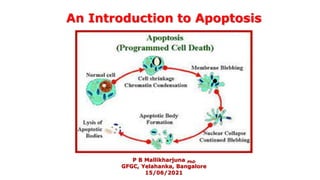This document provides an introduction to apoptosis, or programmed cell death. It discusses how apoptosis is important for homeostasis and shaping tissues during development. Apoptosis is a highly regulated process where cells self-degrade through molecular machinery like caspases. The document outlines the molecular pathways of apoptosis, including the extrinsic, intrinsic, and execution pathways. It also discusses apoptosis in animals, plants, and the roles of autophagy and caspase enzymes.















